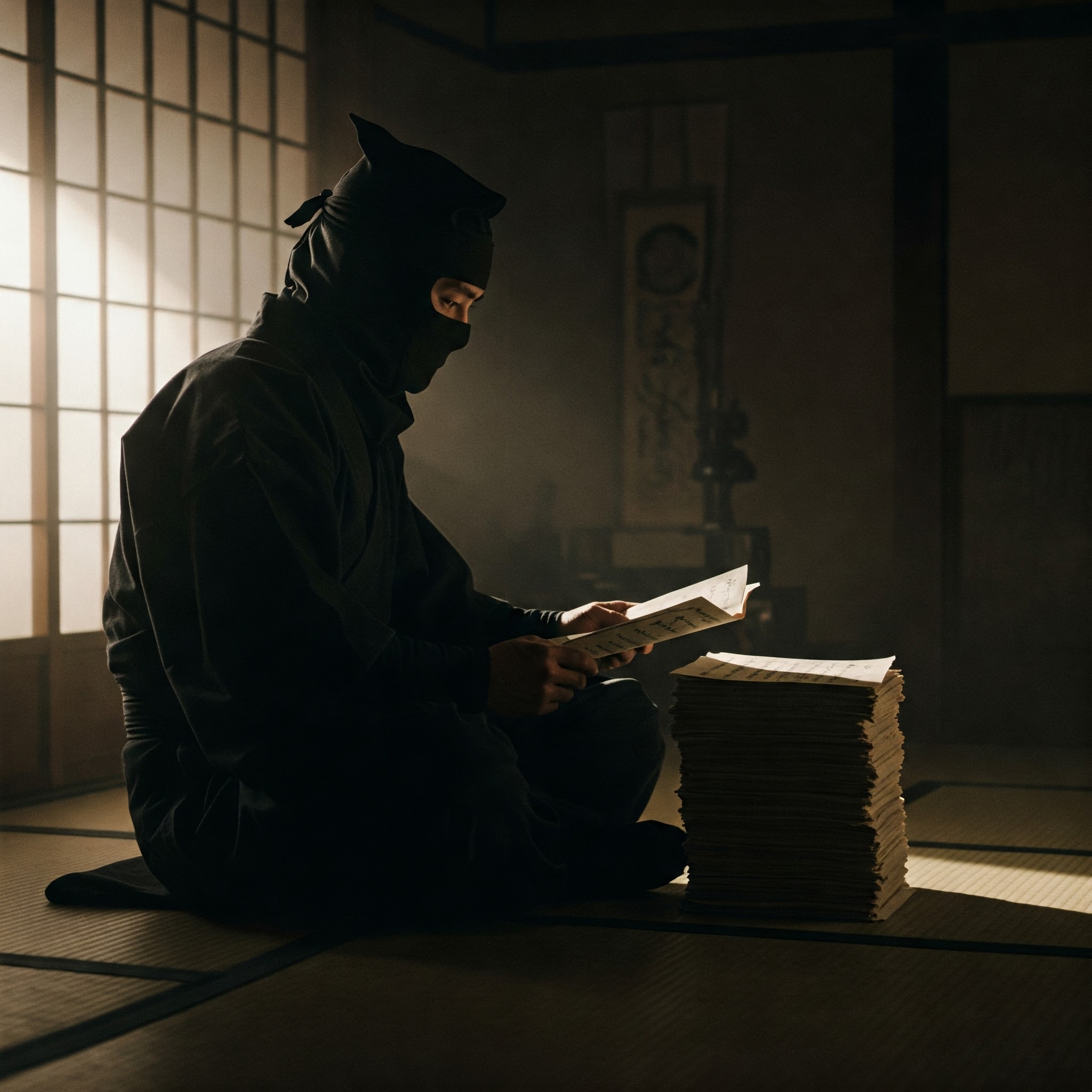忍びの秘伝書「万川集海」とは如何なるものか
忍びの道に生きる者ならば、一度は耳にしたことがあるであろう「万川集海」。それは、忍術の奥義を記した秘伝書であり、忍びたちの間で語り継がれてきた伝説の書物じゃ。さて、この「万川集海」とは、一体如何なるものなのか、紐解いていくとしようかの。
「万川集海」とは
「万川集海」とは、江戸時代前期に編纂された忍術の集大成とも言える書物じゃ。その名の通り、「万の川が海に集まる」という意味が込められており、伊賀、甲賀をはじめとする様々な流派の忍術が網羅されておる。
編纂したのは、甲賀の忍び、藤林左武次保武(ふじばやしさぶじやすたけ)じゃ。彼は、長年にわたり蓄積された忍術の知識を集大成し、延宝4年(1676年)にこの書物を完成させたと言われておる。
「万川集海」の内容
「万川集海」は、全22巻から構成されており、忍びの心得、忍術の技術、忍器の使い方、諜報活動、変装術、薬学など、忍びに関するあらゆる知識が詳細に記されておる。
例えば、忍びの心得としては、精神修養や倫理観、情報収集の方法などが説かれておる。忍術の技術としては、手裏剣術、剣術、体術、隠形術などが解説されておる。忍器の使い方としては、忍刀、鉤縄、撒菱などの道具の使い方や製作方法が図解入りで示されておる。
また、諜報活動や変装術に関する記述も非常に詳細じゃ。敵地に潜入するための方法、情報を収集するための技術、身分を偽るための変装術などが具体的に解説されておる。さらに、薬学に関する知識も豊富じゃ。毒薬や解毒薬の調合方法、薬草の知識などが記されておる。
「万川集海」の価値
「万川集海」は、忍術の知識だけでなく、当時の社会情勢や文化を知る上でも貴重な資料じゃ。この書物には、戦国時代から江戸時代にかけての忍びの活動や思想が反映されており、忍びの歴史を研究する上で欠かせない存在じゃ。
また、「万川集海」は、単なる技術書ではなく、忍びの精神性を説いた書物でもある。忍びの心得や倫理観に関する記述は、現代においても通用する普遍的な価値を持っており、多くの人々に感銘を与えておる。
「万川集海」の現代への影響
「万川集海」は、現代においても忍術研究の基礎資料として活用されておる。忍術に関する書籍や映画、アニメ、ゲームなどにも、この書物に記された知識や技術が取り入れられておる。
また、「万川集海」に説かれた忍びの精神性は、現代社会においても重要な教訓を与えてくれる。例えば、情報収集能力や危機管理能力、精神力などは、ビジネスや日常生活においても役立つ能力じゃ。
まとめ
「万川集海」は、忍術の奥義を記した秘伝書であり、忍びの歴史や文化を知る上で貴重な資料じゃ。この書物に記された知識や技術は、現代においても多くの人々に影響を与えておる。忍びの精神性は、現代社会においても重要な教訓を与えてくれるじゃろう。
「万川集海」は、単なる昔の書物ではなく、現代においても生き続ける忍びの魂を伝える書物と言えるじゃろう。
【以下英語版】【English version below】
What Is the Secret Ninja Manual, Bansenshūkai?
For those who walk the path of the ninja, the name Bansenshūkai is surely familiar. This legendary text is a secret manual containing the profound techniques of ninjutsu, passed down through generations of shinobi. But what exactly is Bansenshūkai? Let us unravel its mysteries.
What Is Bansenshūkai?
Compiled in the early Edo period, Bansenshūkai is regarded as the ultimate compilation of ninjutsu. Its name means “Ten Thousand Rivers Flow into the Sea,” signifying the collection of techniques from various ninja schools, including the famous Iga and Kōga traditions.
The manual was compiled by Fujibayashi Sabuji Yasutake, a ninja from the Kōga region. It is said that he gathered and systematized the knowledge accumulated over generations, completing this monumental work in 1676 (Enpō 4).
Contents of Bansenshūkai
Consisting of 22 volumes, Bansenshūkai covers a vast range of knowledge essential to a ninja’s craft. It details:
- Ninja ethics and philosophy – Mental discipline, moral principles, and intelligence-gathering techniques.
- Ninjutsu techniques – Shuriken throwing, swordsmanship, unarmed combat, and stealth methods.
- Ninja tools and weapons – Illustrated guides on the use and creation of ninja swords, grappling hooks, and caltrops.
- Espionage and disguise – Techniques for infiltration, intelligence gathering, and adopting false identities.
- Medicinal knowledge – Formulas for poisons, antidotes, and the use of medicinal herbs.
The manual provides detailed descriptions, often accompanied by diagrams, allowing its readers to master the art of ninjutsu.
The Value of Bansenshūkai
Beyond being a ninjutsu textbook, Bansenshūkai serves as an invaluable historical document, offering insight into the social and cultural context of the time. It reflects the activities and philosophies of ninja from the Sengoku to the Edo period, making it indispensable for the study of ninja history.
Furthermore, Bansenshūkai is not merely a technical guide; it also emphasizes the spiritual and ethical aspects of ninjutsu. Its teachings on discipline, adaptability, and intelligence remain relevant even today, inspiring many who seek to develop their inner strength.
Modern Influence of Bansenshūkai
Even in the modern era, Bansenshūkai continues to be a foundational text for the study of ninjutsu. Elements from this book have been incorporated into literature, movies, anime, and video games, keeping the legacy of ninja alive.
Additionally, its teachings on intelligence gathering, crisis management, and mental resilience offer valuable lessons applicable to business, leadership, and everyday life.
Conclusion
Bansenshūkai is more than just an ancient ninja manual; it is a treasure trove of knowledge, preserving the essence of ninjutsu and its history. Its influence extends far beyond its time, continuing to inspire those fascinated by the way of the ninja.
Even today, Bansenshūkai serves as a bridge between the past and present, ensuring that the spirit of the ninja endures through the ages.



